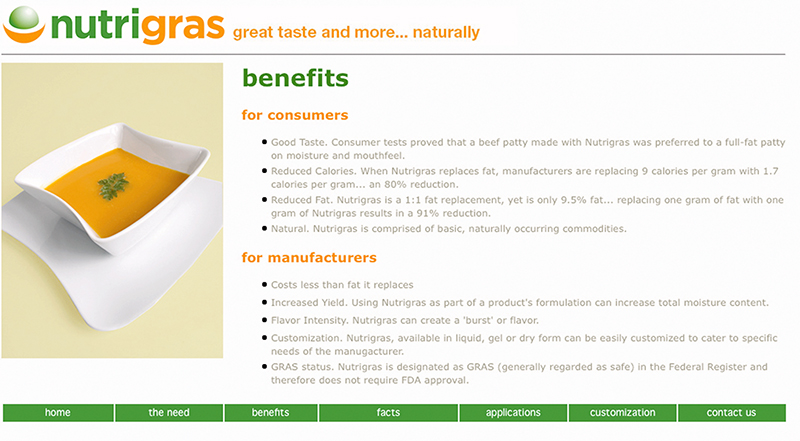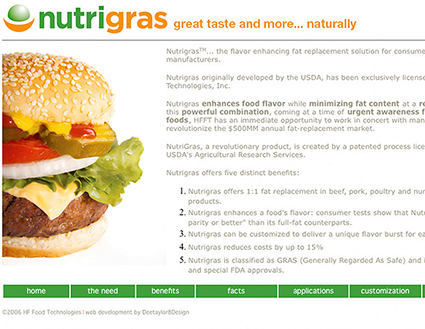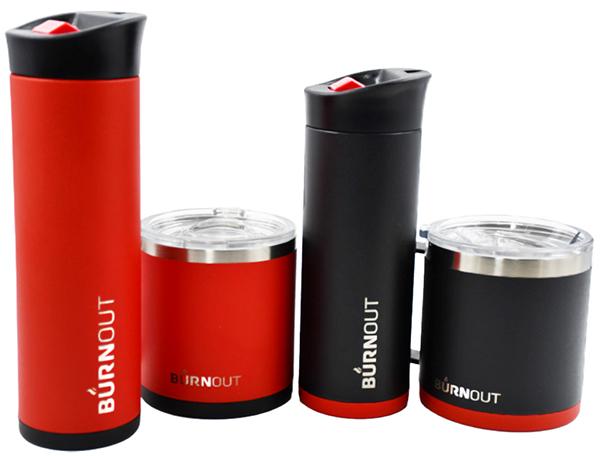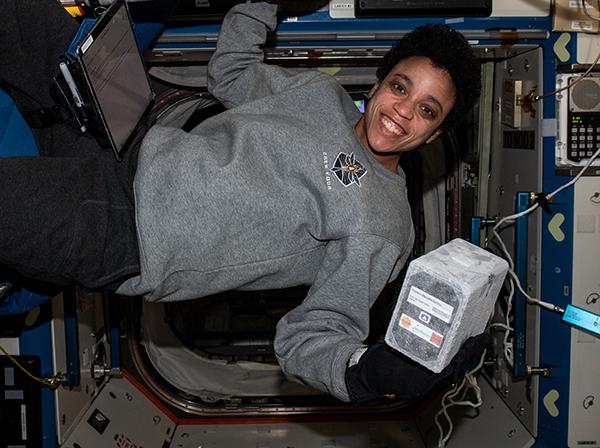
Food Supplement Reduces Fat, Improves Flavor
Originating Technology/NASA Contribution
During the Mercury missions, astronauts ate terrible food: freeze-dried powders and semi- liquids in aluminum tubes. Decades later, though, astronauts now have meals prepared by celebrity chefs and access to everyday items like shrimp cocktail, stir-fried chicken, and fettuccine alfredo. While the culinary selection has improved, the developers of these gourmet delights are still faced with a number of challenges.
Space foods, which can be available in rehydratable, thermostabilized, irradiated, and natural forms, are tested for their nutritional value, appeal to the senses, storability, and packaging. The foods are also tested to ensure that they are low in weight and mass, require little energy to prepare for eating, have a minimum of 9 months shelf life for shuttle missions and 1 year for use on the International Space Station (ISS), and are stored at room temperature.
Additional challenges include the need to develop foods and equipment that take up very little space, are easy to operate and clean, and require minimal water use, while also creating minimal air pollution and odors, which can be hazardous to the health and well-being of astronauts. The foods must be crumb-free to eliminate excess floating particles. Space foods must also be free of pathogenic microbes and create minimum waste and mess.
Finally, space foods have to taste good, while still managing to be healthy. Toward this effort, NASA testing helped in the development of a revolutionary new fat substitute that cuts calories and extends shelf life.
Partnership
The NASA Glenn Garrett Morgan Commercialization Initiative (GMCI) is a program for small, minority-owned, and woman-owned businesses that can benefit from access to NASA resources. GMCI provides services that enable companies to grow and strengthen their business by leveraging NASA technology, expertise, and programs.
Diversified Services Corporation, a minority-owned business based out of Cleveland, Ohio, was able to take advantage of this NASA program for technology acquisition and development, and for introductions to potential customers and strategic partners, such as the NASA Food Technology Commercial Space Center, at Iowa State University (the center closed December 31, 2005), for taste tests and performance studies. Fresh ground beef (90-percent lean) was used to prepare hamburger patties formulated with or without 10-percent fat substitute. Hamburger patties without the added fat substitute served as the control in each experiment. Patties were weighed for evaluation of cooking yield, and then cooked to an internal temperature of 72 °C. The cooked product with or without fat substitute was rapidly cooled, and then subjected to freeze drying or irradiation in retort pouches to NASA specifications. Changes in volatile profile during storage, and sensory properties were determined. Addition of 10-percent fat substitute did not influence the sensory characteristics of the ready-to-eat hamburger beef patties or dramatically change its volatile profile after 30-day storage.
With the GMCI assistance, the company developed and commercialized a new nutritional fat replacement and flavor enhancement product it had licensed from the U.S. Department of Agriculture and is now marketing it through its subsidiary, H.F. Food Technologies Inc.
Product Outcome
The Nutrigras fat substitute is available for commercial applications and helps to satisfy the body’s desire for the taste and mouth feel of fatty foods, even though the body does not actually need these foods—in fact, many people need fewer high-fat foods in their diets. With obesity on the verge of outweighing smoking as the number one cause of preventable death, the Centers for Disease Control and Prevention are showing rapid rises in the prevalence of children at severe weight levels; and while the American diet continues to be reliant on large quantities of high-fat foods, nutritionists are searching for solutions.
Nutrigras is one such solution. It is a stable emulsion of 9-percent vegetable oil and 62-percent water that has been formed by turbid excess steam jet cooking and made stable with microencapsulation in a starch solution that holds the emulsion steady. It is available in liquid, gel, or dry form and can be easily customized to the specific needs of the food manufacturer. When constituted, it looks and tastes just like real fat, but it is significantly healthier.
It is primarily intended for use as a partial replacement for animal fat in beef patties and other normally high-fat meat products, but can also be used in soups, sauces, bakery items, and desserts.
Nutrigras is intended to be used as a direct, pound- for-pound replacement of fat, and since it is only 9-percent fat, it is possible to produce products that have 90-percent less fat than their full-fat counterparts. It contains 80-percent fewer calories per gram than fat.
In addition to the nutritional benefits, the fat replacement has added industrial benefits. First, it costs less than the food it replaces and can help manufacturers reduce material costs. Secondly, in precooked products, Nutrigras can increase moisture content, which increases product yield. For example, in research on cooked beef, the Nutrigras-enhanced product shrank 10-percent less than the beef that had not received the additive.
It is healthy, has wide-spread applicability, and is more cost effective than using full-fat products; but really, how does it taste? That is the big breakthrough. With Nutrigras, the finished product is more moist and tender. Quantitative consumer testing conducted by the company indicated that a beef patty made with Nutrigras was actually preferred to the full-fat beef patty. The unique structure of Nutrigras allows for improved flavor delivery. The construction of Nutrigras is receptive to the addition of flavors that can be carried and then released in a “burst” when consumed. This can be positioned as a point of difference for food manufacturers.
The company has been working on a number of specific applications, with the primary focus on beef, pork, chicken, and turkey. Work has also been done to enhance the performance of various baked goods, ice creams, ice cream novelties, soups, sauces, and salad dressings.
Development work and testing has been completed on beef patties. In beef, optimal results have been obtained when converting 80/20 ground beef (80-percent lean meat/20-percent fat) to 80/15/5 (80-percent lean meat/15-percent Nutrigras/5-percent fat.) Product testing is currently underway on pork sausage and chicken, and one customer is currently working on a turkey enhancement.
Nutrigras can be used to add flavors to a variety of baked goods, resulting in reduced fat and calories while enhancing flavor. Moreover, preliminary research has indicated the potential for product stability benefits from Nutrigras. Baked goods are left moister, better tasting, and the resultant product contains less fat and fewer calories.
Ice cream can be made with less heavy cream by replacing a portion of the cream with Nutrigras. Overall costs are reduced (cream is more costly than Nutrigras), and the flavor profile is enhanced and improved. In addition, unique flavors can be obtained through customized formulations. Nutrigras can act as a stabilizer and reduce the use of extraneous gums and emulsifiers that are expensive and clutter product labels. Nutrigras has also demonstrated the ability to reduce the negative freeze/thaw characteristics of conventional ice cream.
Additionally, soups can be flavor enhanced, better tasting, and have improved mouth feel. Low-fat sauces and salad dressings can be improved in similar fashions.
The company has been able to repay the help provided by NASA by contributing to the Space Agency’s astronaut diet. The Nutrigras fat substitute can be used as a flavor enhancer and shelf-life extender for use on the ISS.
Nutrigras™ is a trademark of H.F. Food Technologies Inc.

Diversified Services Corporation developed and commercialized a new nutritional fat replacement and flavor enhancement product with assistance from NASA.

The Nutrigras food supplement creates food that is more moist, more tender, and more flavorful than its full-fat counterpart, and 1 pound of the supplement replaces 1 pound of animal fat.













